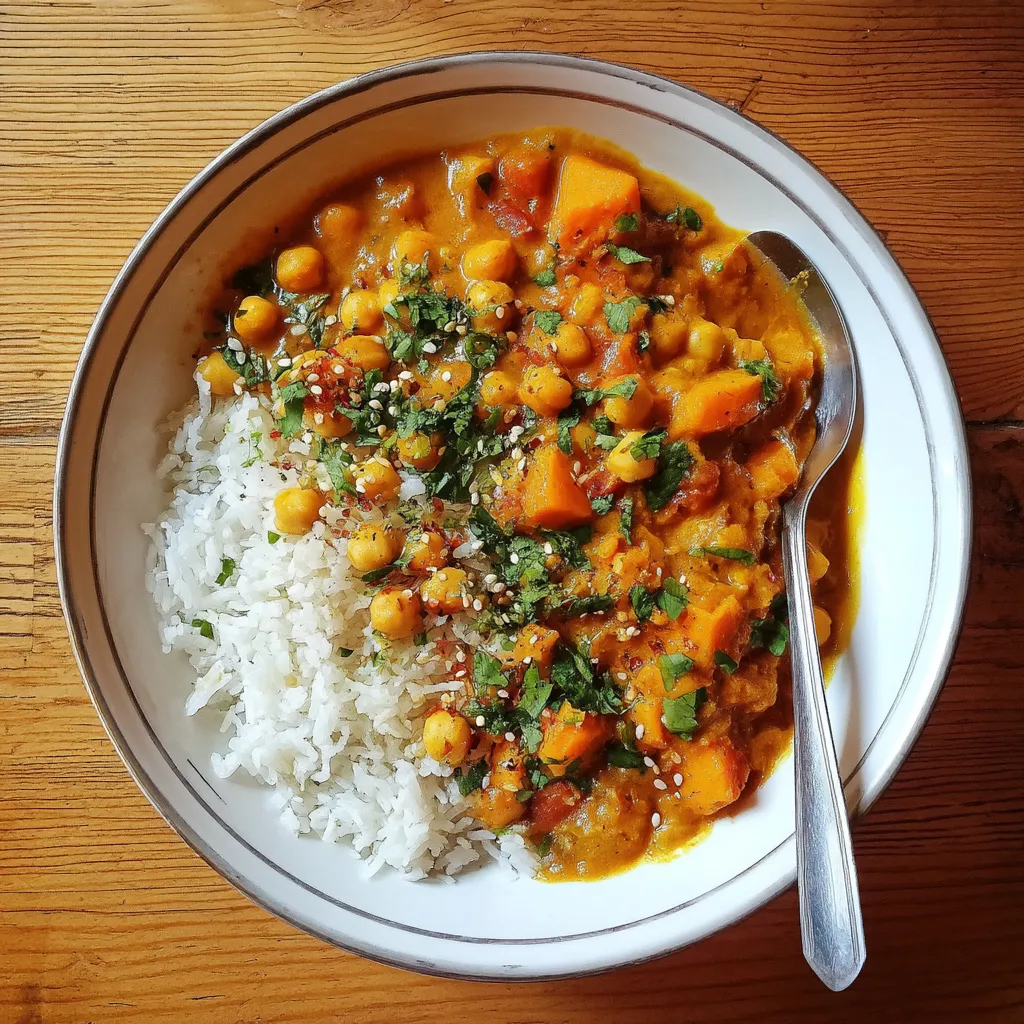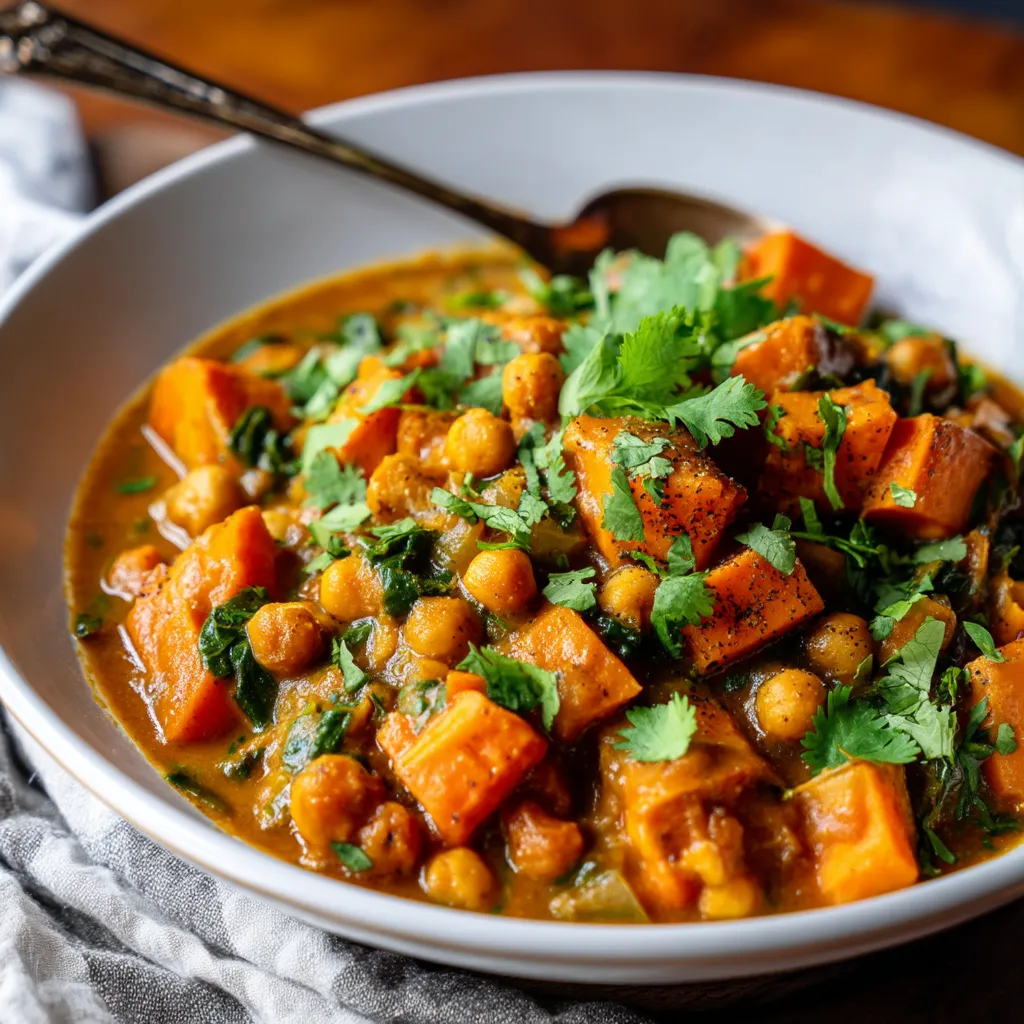 Save It
Save It This sweet potato chickpea curry has become my go-to comfort meal during busy weeknights, combining hearty vegetables with aromatic spices for a satisfying plant-based dinner that never disappoints.
I first created this curry during a particularly cold winter evening when I was craving something warming but had limited ingredients. What started as a simple pantry meal has evolved into the most requested dish when friends come over for dinner.
Ingredients
- Sweet potatoes: Provide natural sweetness and a buttery texture when cooked. Look for firm ones with uniform color
- Chickpeas: Offer protein and satisfying texture. Rinse canned ones thoroughly to remove excess sodium
- Coconut milk: Creates the luxurious base. Use full fat for the creamiest results
- Curry powder: Forms the flavor foundation. Choose a fresh blend with vibrant color for best results
- Fresh ginger: Adds essential warmth. Store your root in the freezer and grate while frozen for easiest use
- Tomatoes: Bring acidity to balance the sweetness. Fire roasted add extra depth if available
- Spinach or kale: Fold in easily for added nutrition. Baby spinach requires no prep while kale benefits from removing the stems
- Spices like cumin and turmeric: Work together to create complex flavor. Toast them briefly to bloom their oils
Step-by-Step Instructions
- Sauté The Aromatics:
- Start with medium heat and cook onions in coconut oil until they become translucent and fragrant, about 4 to 5 minutes. The natural sugars will begin to release, creating the first layer of flavor for your curry. Adding a tiny pinch of salt here helps draw out moisture.
- Activate The Spices:
- Add garlic and ginger to the softened onions and cook for exactly one minute, stirring constantly. The mixture will become intensely aromatic. Next, add all dry spices and toast them for 30 seconds while stirring continuously. This crucial step wakes up the essential oils in the spices, transforming their flavor from flat to vibrant.
- Build The Base:
- Add sweet potatoes and chickpeas, stirring thoroughly to ensure every piece gets coated in the spice mixture. This coating protects the vegetables from burning while infusing them with flavor. Pour in tomatoes and coconut milk, stirring to combine completely.
- Simmer To Perfection:
- Bring the mixture to a gentle simmer, then reduce heat slightly, cover, and cook for 20 to 25 minutes. Check occasionally and stir gently to prevent sticking. The curry is ready when you can easily pierce sweet potatoes with a fork but they still hold their shape. If the curry becomes too thick during cooking, add water or broth a few tablespoons at a time.
- Finish And Season:
- Stir in fresh greens just before serving, allowing the residual heat to wilt them perfectly without overcooking. Taste the curry and adjust seasoning with salt and pepper. The flavors should be balanced between sweet, savory, and spicy.
 Save It
Save It The first time I served this curry to my skeptical father in law, he asked for seconds and then requested the recipe. The sweet potatoes are truly the star ingredient here, as they absorb all the curry flavors while maintaining their own natural sweetness. Their vibrant orange color against the yellowy sauce creates a dish that's as beautiful as it is delicious.
Make-Ahead Options
This curry actually improves with time as the flavors meld together. I often make a double batch on Sunday and enjoy it throughout the week. To store, cool completely before transferring to airtight containers. Refrigerate for up to 4 days. When reheating, add a splash of water or coconut milk if it's thickened too much in storage. The sweet potatoes will continue to absorb liquid over time, making the sauce thicker but even more flavorful.
Clever Substitutions
This recipe welcomes adaptation based on what you have available. Butternut squash works beautifully in place of sweet potatoes, offering a similar sweetness with slightly different texture. No chickpeas? Try white beans or lentils instead. For the coconut milk, light versions work but will create a thinner sauce. In a pinch, cashew cream makes a wonderful substitute that maintains the creaminess. If you prefer a milder curry, simply reduce the curry powder by half and omit the cayenne completely.
 Save It
Save It Serving Suggestions
While this curry is delicious on its own, pairing it with the right sides elevates the meal. Fluffy basmati rice makes the perfect base to soak up the flavorful sauce. For something different, try serving with quinoa for extra protein or cauliflower rice for a lower carb option. Fresh naan bread makes an excellent accompaniment for scooping. For toppings, toasted coconut flakes add wonderful texture contrast, while a dollop of plain yogurt cools the spice level for those with sensitive palates. If serving for guests, create a toppings bar with chopped peanuts, fresh herbs, and sliced chilies.
Common Questions About Recipes
- → Can I make this curry ahead of time?
Yes! This curry actually tastes even better the next day as the flavors have more time to develop. Store in an airtight container in the refrigerator for up to 3 days. Reheat gently on the stovetop or microwave before serving.
- → What can I substitute for coconut milk?
For a lighter version, you can use light coconut milk. Alternatively, try unsweetened cashew cream, oat cream, or a plant-based cooking cream. The flavor profile will change slightly, but the dish will still be delicious.
- → How do I adjust the spice level?
To make it milder, omit the cayenne pepper and reduce the curry powder to 2 teaspoons. For extra heat, increase the cayenne to 1/2 teaspoon or add a finely chopped fresh chili with the garlic and ginger.
- → Can I use dried chickpeas instead of canned?
Yes, but you'll need to cook them separately first. Soak 1 cup dried chickpeas overnight, then simmer in fresh water for about 45 minutes until tender before adding them to the curry.
- → What vegetables can I add to this curry?
This curry is versatile and works well with many vegetables. Try adding bell peppers, cauliflower, carrots, peas, or eggplant. Add harder vegetables earlier in the cooking process and quick-cooking ones like peas toward the end.
- → Is this curry freezer-friendly?
Absolutely! Cool the curry completely, then portion into airtight containers. Freeze for up to 3 months. Thaw overnight in the refrigerator and reheat thoroughly before serving.